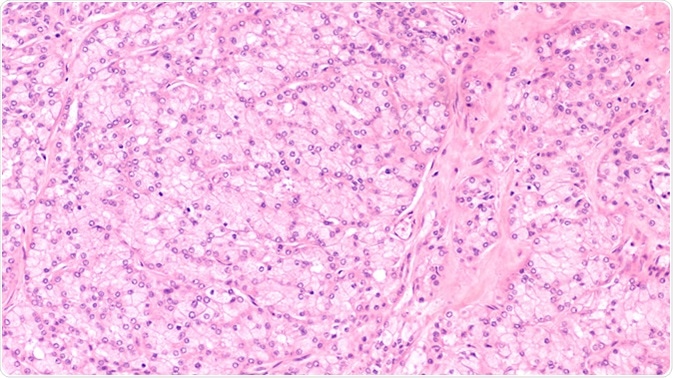Overview
As salivary glands are made up of different cells, tumors could start in any one of such. Various salivary gland tumors, which may be benign or malignant, may develop within and around the mouth, and could cause cancers of various severity.

Microscopic image of an acinic cell carcinoma, a rare cancer of salivary glands such as parotid, submandubular or sublingual gland. They derive from acinar cells and have finely granular cytoplasm. - Image Credit: By David Litman / Shutterstock
Acinic cell carcinoma is a rare cancer of the salivary glands that originates from the parotid gland. It is a low-grade salivary neoplasm that constitutes about 5% to 17% of cases involving salivary gland malignancies. In comparison with other salivary gland cancers, acinic cell carcinoma is relatively slow-growing, and progresses among younger individuals. The prognosis of this type of cancer heavily depends on the rate of its metastasis. Acinic cell carcinoma is more prevalent in women than in men.
The exact cause of salivary gland cancers, including acinic cell carcinoma, is unknown; however, research suggests that possible causes of the disease may be previous exposure to radiation, wood dust inhalation, and a family history of salivary cancers.
Acinic cell carcinoma FNA Cytology
Symptoms and Diagnosis of Acinic Cell Carcinoma
Patients with acinic cell carcinoma would usually present with a growing mass lesion in the parotid region initially; however, its diagnosis is confirmed through a fine needle aspiration biopsy. For diagnosing acinic cell carcinoma, the following microscopic features should be looked for in the suspected cancerous tissue:
- Significantly abnormal basophilia and prominent lymphoid infiltrate
- Multidirectional differentiation of the tumor, especially in acinar cells
- Presentation of four variable patterns including microcystic, follicular, solid, and papillary cystic
- Presentation of prominent lymphoid follicles at periphery
Patients diagnosed with acinic cell carcinoma are also expected to present with the following physiologic symptoms:
- Pain, including flak pain
- Gastrointestinal symptoms including nausea and vomiting
- Loss of appetite
- Difficulty in digestion
- Bloating, flatulence, or fullness
- Change in bowel habits
- Fatty stool
- Gastrointestinal bleeding
Acinic cell carcinoma rarely metastasize; however, when it does, it affects the local regions including the contralateral orbit, submandibular lymph node, and submandibular salivary gland, as well as other body regions including the brain and lungs. The recurrence or relapse of the condition is also common.
Treating Acinic Cell Carcinoma
While surgical excision is usually done to treat acinic cell carcinoma, modern research has examined the possibility of radiotherapy as a treatment procedure. This is due to the treatment hypothesis that parotid cancer patients would generally demonstrate survival with adjuvant radiotherapy. Unfortunately, results of the study showed that the people diagnosed with acinic cell carcinoma and treated using radiotherapy did not have good survival outlooks, even for early-stage or lower-grade acinic cell carcinoma.
At present, common cancer treatment therapies, such as chemotherapy, are being used to treat the condition. Meanwhile, the researchers are trying to examine the use of checkpoint inhibitors in treatment.
Further Reading
Last Updated: Jun 18, 2019